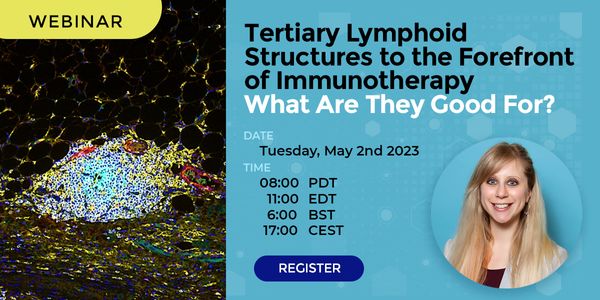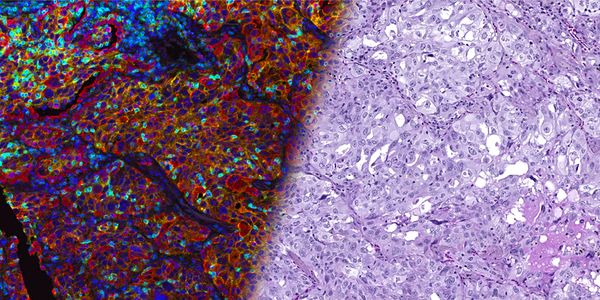Prognosis for cancers
When diagnosed with cancer, doctors may provide a patient with a prognosis, an estimate or how the cancer will progress and how well it will respond to treatment. Prognoses account for many factors, including demographic variables like the patient's age and comorbidities, and clinical characteristics of the cancer, like the type, stage, grade, and expression of known treatment targets. Prognoses are based on prior biomedical research and outcome data.
-
JAN 18, 2024 | 10:00 AMIn 2020, American Cancer Society released an updated cervical cancer screening guideline calling for primary human papillomavirus (HPV) screening as the preferred strategy. Utility of HPV pr...OCT 30, 2023 | 8:00 PMDescription: Join this two-part webinar to learn how capillary electrophoresis (CE) complements sequencing technologies, such as next generation sequencing, that are being used by cancer res...OCT 26, 2023 | 8:00 AMDescription: Join this two-part webinar to learn when capillary electrophoresis is an ideal choice relative to other various sequencing technologies – such as next generation sequencin...SEP 19, 2023 | 11:00 AMC.E. CREDITSCurrent clinical methods used to identify epithelial ovarian cancer are often too late – when the cancer is at an advanced stage, leaving the patient with limited therapeutic options....JUL 18, 2023 2:00 PM EDTC.E. CREDITSWorldwide gastric cancer is the 5th most common cancer and the 4th leading cause of cancer deaths. Its highest incidence rates are in east Asia and eastern Europe with low incidence rates in...MAY 02, 2023 | 8:00 AMC.E. CREDITSAbstract Learning Objectives Define a tertiary lymphoid structure in human cancer Describe the tumor microenvironment factors that influence the formation of tertiary lymphoid structures Ide...MAR 30, 2023 | 5:10 PMThis talk will highlight key changes to the various guidelines in myeloid and lymphoid testing, commenting on the current and future landscape of biomarkers. The speakers will then share the...Speaker: Dr. Geetha Menon, MD , Lihui Wang, PhDPresented at: OncomineWorld 2024: A Virtual NGS Education Meeting
MAR 30, 2023 | 8:00 AMDate: March 30, 2023 Time: 8:00am (PST), 11:00am (EST), 5:00pm (CET) Join the Gibco Cell Culture Heroes webinar featuring Heather Beasley, PhD as she presents "SLC25A46 as a Novel Mitoc...MAR 30, 2023 | 1:50 PMClinical laboratories worldwide are implementing various targeted panels to identify cancer genomic variants and ultimately improve patient outcomes. As most of the panels and NGS platforms ...MAR 30, 2023 | 1:50 PMClinical laboratories worldwide are implementing various targeted panels to identify cancer genomic variants and ultimately improve patient outcomes. As most of the panels and NGS platforms...MAR 30, 2023 | 12:25 PMNext-generation sequencing can detect multiple driver oncogenes simultaneously, enabling the analysis of limited amounts of biopsied tissue samples. . Druggable driver mutations cover more t...MAR 30, 2023 | 12:25 PMNext-generation sequencing can detect multiple driver oncogenes simultaneously, enabling the analysis of limited amounts of biopsied tissue samples. . Druggable driver mutations cover more t...NOV 09, 2022 | 12:45 PMIn the next five years, the majority of clinical diagnostic labs competing to offer NGS oncology testing will be performing comprehensive genomic profiling (CGP). Yet scaling to CGP introduc...Speaker: Beate Litzenburger, Ph.D.NOV 09, 2022 | 6:00 AMCancer is a heterogeneous but related group of diseases wherein cells in certain tissues of the body proliferate uncontrollably and eventually invade adjacent and distant tissues. The oldest...Speaker: Vrajesh Pandya, PhDOCT 26, 2022 | 8:00 AMDate: October 26, 2022 Time: 8:00am (PDT), 11:00am (EDT), 5:00pm (CEST) Immunotherapy has transformed the treatment of metastatic and recurrent solid tumors. Advances in technology in the pa...OCT 06, 2022 | 6:00 AMBreast cancer is the number one cause of cancer in women. Although many risk factors for breast cancer have been identified, only some are modifiable. Since 2004, incidence rates have been r...Speaker: Rulla Tamimi, ScDOCT 06, 2022 | 6:00 AMIn real-world evidence (RWE), temporal shifts in clinical knowledge and practice need to be adjusted for treatment effect assessment. We use electronic health records (EHR) data to 1) assess...Speaker: Jue "Marquis" HouOCT 04, 2022 | 6:00 AMArtificial Intelligence (AI) is a computer program designed to perform operations typical of human intelligence, such as self-learning. AI is taking over different fields in science; we alre...Speaker: Martha HernándezAPR 21, 2022 | 5:30 AMA hypoxic tumour microenvironment is a feature of solid tumours. Many tumour types contain high fractions of hypoxic tissue. The relationship between high levels of tumour hypoxia and a poor...APR 20, 2022 | 7:30 AMThe COVID-19 pandemic has taken a dramatic toll worldwide. Its impact possibly has been the most palpable amongst uniquely vulnerable groups of patients, such as patients with a cancer diagn...FEB 23, 2022 | 11:55 PMCancer is a leading cause of morbidity and mortality in developed countries including the United States. Early detection of various cancers, before they spread and become incurable, has been...Speaker: Hilal Arnouk, MD, PhDPresented at: Drug Discovery & Development Virtual Event Series 2022
JAN 20, 2022 | 8:00 AMDate: January 20, 2021 Time: 08:00am (PST), 11:00am (EST) Automated staining platforms and digital slide scanners have revolutionized tissue-based biomarker research by providing a powerful...OCT 06, 2021 | 12:00 AMAfrican American women face a lower risk of being diagnosed with breast cancer as compared to Caucasian-American women, yet they paradoxically face an increased breast cancer mortality hazar...Speaker: Checo J. Rorie, PhDJUN 02, 2021 | 12:00 AMRhabdomyosarcoma (RMS) is a soft tissue cancer commonly arising in muscle and is the most common soft tissue cancer in children. Patients with metastatic RMS have a poor prognosis that has n...
JAN 18, 2024 | 10:00 AM
In 2020, American Cancer Society released an updated cervical cancer screening guideline calling for primary human papillomavirus (HPV) screening as the preferred strategy. Utility of HPV pr...
OCT 30, 2023 | 8:00 PM
Description: Join this two-part webinar to learn how capillary electrophoresis (CE) complements sequencing technologies, such as next generation sequencing, that are being used by cancer res...
OCT 26, 2023 | 8:00 AM
Description: Join this two-part webinar to learn when capillary electrophoresis is an ideal choice relative to other various sequencing technologies – such as next generation sequencin...
SEP 19, 2023 | 11:00 AM
C.E. CREDITS
Current clinical methods used to identify epithelial ovarian cancer are often too late – when the cancer is at an advanced stage, leaving the patient with limited therapeutic options....
JUL 18, 2023 2:00 PM EDT
C.E. CREDITS
Worldwide gastric cancer is the 5th most common cancer and the 4th leading cause of cancer deaths. Its highest incidence rates are in east Asia and eastern Europe with low incidence rates in...
MAY 02, 2023 | 8:00 AM
C.E. CREDITS
Abstract Learning Objectives Define a tertiary lymphoid structure in human cancer Describe the tumor microenvironment factors that influence the formation of tertiary lymphoid structures Ide...
MAR 30, 2023 | 5:10 PM
This talk will highlight key changes to the various guidelines in myeloid and lymphoid testing, commenting on the current and future landscape of biomarkers. The speakers will then share the...
Speaker:
Dr. Geetha Menon, MD
, Lihui Wang, PhD
Presented at: OncomineWorld 2024: A Virtual NGS Education Meeting
MAR 30, 2023 | 8:00 AM
Date: March 30, 2023 Time: 8:00am (PST), 11:00am (EST), 5:00pm (CET) Join the Gibco Cell Culture Heroes webinar featuring Heather Beasley, PhD as she presents "SLC25A46 as a Novel Mitoc...
MAR 30, 2023 | 1:50 PM
Clinical laboratories worldwide are implementing various targeted panels to identify cancer genomic variants and ultimately improve patient outcomes. As most of the panels and NGS platforms ...
MAR 30, 2023 | 1:50 PM
Clinical laboratories worldwide are implementing various targeted panels to identify cancer genomic variants and ultimately improve patient outcomes. As most of the panels and NGS platforms...
MAR 30, 2023 | 12:25 PM
Next-generation sequencing can detect multiple driver oncogenes simultaneously, enabling the analysis of limited amounts of biopsied tissue samples. . Druggable driver mutations cover more t...
MAR 30, 2023 | 12:25 PM
Next-generation sequencing can detect multiple driver oncogenes simultaneously, enabling the analysis of limited amounts of biopsied tissue samples. . Druggable driver mutations cover more t...
NOV 09, 2022 | 12:45 PM
In the next five years, the majority of clinical diagnostic labs competing to offer NGS oncology testing will be performing comprehensive genomic profiling (CGP). Yet scaling to CGP introduc...
Speaker:
Beate Litzenburger, Ph.D.
NOV 09, 2022 | 6:00 AM
Cancer is a heterogeneous but related group of diseases wherein cells in certain tissues of the body proliferate uncontrollably and eventually invade adjacent and distant tissues. The oldest...
Speaker:
Vrajesh Pandya, PhD
OCT 26, 2022 | 8:00 AM
Date: October 26, 2022 Time: 8:00am (PDT), 11:00am (EDT), 5:00pm (CEST) Immunotherapy has transformed the treatment of metastatic and recurrent solid tumors. Advances in technology in the pa...
OCT 06, 2022 | 6:00 AM
Breast cancer is the number one cause of cancer in women. Although many risk factors for breast cancer have been identified, only some are modifiable. Since 2004, incidence rates have been r...
Speaker:
Rulla Tamimi, ScD
OCT 06, 2022 | 6:00 AM
In real-world evidence (RWE), temporal shifts in clinical knowledge and practice need to be adjusted for treatment effect assessment. We use electronic health records (EHR) data to 1) assess...
Speaker:
Jue "Marquis" Hou
OCT 04, 2022 | 6:00 AM
Artificial Intelligence (AI) is a computer program designed to perform operations typical of human intelligence, such as self-learning. AI is taking over different fields in science; we alre...
Speaker:
Martha Hernández
APR 21, 2022 | 5:30 AM
A hypoxic tumour microenvironment is a feature of solid tumours. Many tumour types contain high fractions of hypoxic tissue. The relationship between high levels of tumour hypoxia and a poor...
APR 20, 2022 | 7:30 AM
The COVID-19 pandemic has taken a dramatic toll worldwide. Its impact possibly has been the most palpable amongst uniquely vulnerable groups of patients, such as patients with a cancer diagn...
FEB 23, 2022 | 11:55 PM
Cancer is a leading cause of morbidity and mortality in developed countries including the United States. Early detection of various cancers, before they spread and become incurable, has been...
Speaker:
Hilal Arnouk, MD, PhD
Presented at: Drug Discovery & Development Virtual Event Series 2022
JAN 20, 2022 | 8:00 AM
Date: January 20, 2021 Time: 08:00am (PST), 11:00am (EST) Automated staining platforms and digital slide scanners have revolutionized tissue-based biomarker research by providing a powerful...
OCT 06, 2021 | 12:00 AM
African American women face a lower risk of being diagnosed with breast cancer as compared to Caucasian-American women, yet they paradoxically face an increased breast cancer mortality hazar...
Speaker:
Checo J. Rorie, PhD
JUN 02, 2021 | 12:00 AM
Rhabdomyosarcoma (RMS) is a soft tissue cancer commonly arising in muscle and is the most common soft tissue cancer in children. Patients with metastatic RMS have a poor prognosis that has n...






















